 As much as I felt at home in Catania, it felt good to get back on the water. With just three weeks on Pantelisa, I was the old hand; in years as well as time on board. We had new crew: Thomas, the skipper, and Julien ‘the hitcher’.
As much as I felt at home in Catania, it felt good to get back on the water. With just three weeks on Pantelisa, I was the old hand; in years as well as time on board. We had new crew: Thomas, the skipper, and Julien ‘the hitcher’.
We set off just after first light to make the best of the weather: sunny with light airs and we turned north along the coast to the Straits of Messina.
 The sail was hoisted and Thomas repaired a broken sail track slide that no-one had noticed before with a neighbouring one missing a loop with nowhere to hang the sail. The sun was warm and the following swell gently rocked us along. Etna’s peak to the east protruding the top of the fluffy cumulus, adding her own faint plume. We would arrive at Messina around 4pm and should be around the cape before dark.
The sail was hoisted and Thomas repaired a broken sail track slide that no-one had noticed before with a neighbouring one missing a loop with nowhere to hang the sail. The sun was warm and the following swell gently rocked us along. Etna’s peak to the east protruding the top of the fluffy cumulus, adding her own faint plume. We would arrive at Messina around 4pm and should be around the cape before dark.
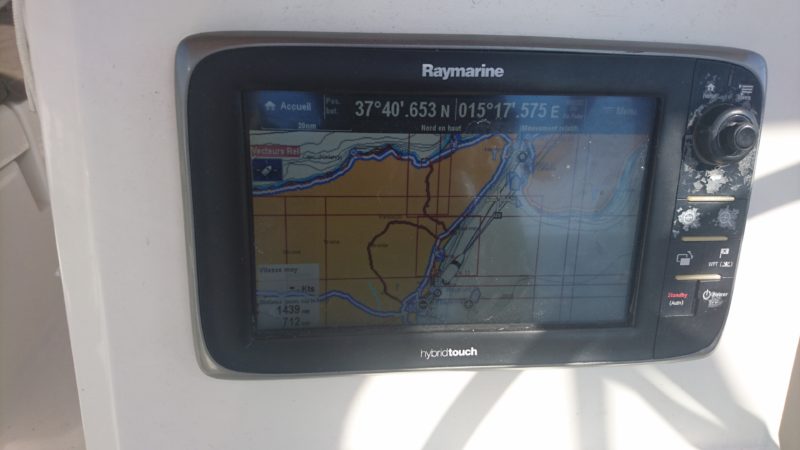 The narrow Straits of Messina are a funnel, both for traffic and current. Traffic was light and the frequent ferries between Sicily and the toe of Italy’s boot were easy to avoid. The current was against us and the gentle swell turned into a spiky chop. The water was like a washing machine and we lost a couple of knots speed. Further north, the current reversed and travelled with the wind and swell, the water smoothed to almost a slick and our speed boosted to 10 knots.
The narrow Straits of Messina are a funnel, both for traffic and current. Traffic was light and the frequent ferries between Sicily and the toe of Italy’s boot were easy to avoid. The current was against us and the gentle swell turned into a spiky chop. The water was like a washing machine and we lost a couple of knots speed. Further north, the current reversed and travelled with the wind and swell, the water smoothed to almost a slick and our speed boosted to 10 knots.
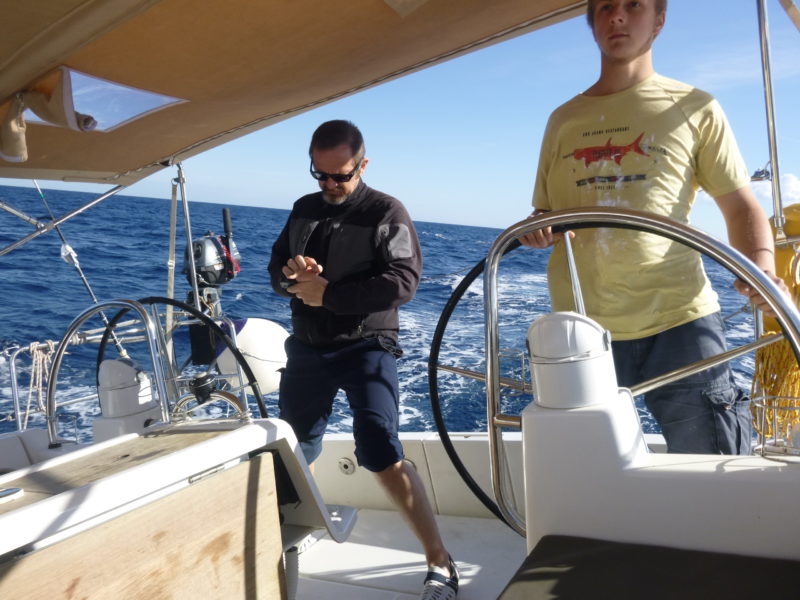 Rounding the cape at Torre Faro, our gentle following breeze turned into a lively broad reach and, with the wind chill, the temperature began falling along with the evening sun. The gusts were trying to round us up into the wind but we held on knowing we would be in the lee to the north of Etna in about half an hour. In Etna’s lee, things became quiet. We fired up the engine and I turned in to get some rest before my early morning shift.
Rounding the cape at Torre Faro, our gentle following breeze turned into a lively broad reach and, with the wind chill, the temperature began falling along with the evening sun. The gusts were trying to round us up into the wind but we held on knowing we would be in the lee to the north of Etna in about half an hour. In Etna’s lee, things became quiet. We fired up the engine and I turned in to get some rest before my early morning shift.
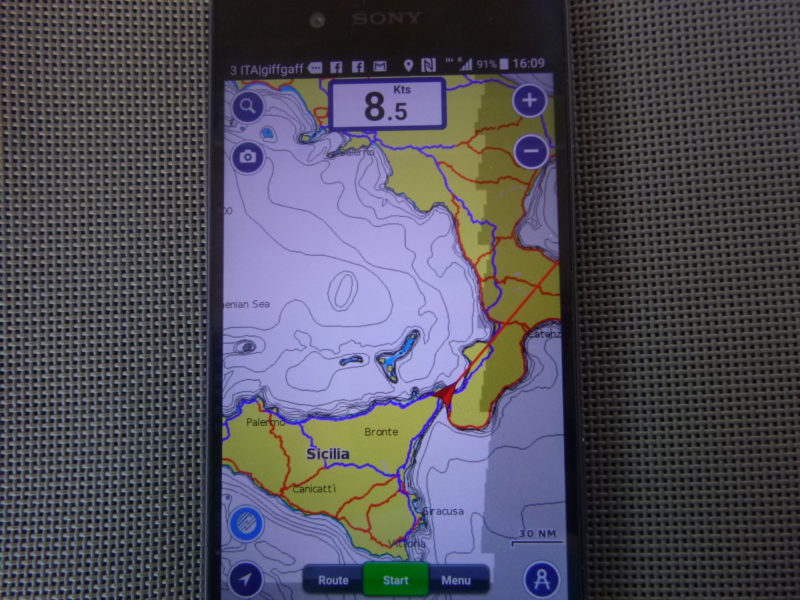 The wind and sea picked up as we emerged from the mountain’s shelter, so we edged closer to shore for an easier life. My watch was to be from 3am but with the state of the sea banging the hull under my bunk, I couldn’t sleep so was up on deck from midnight.
The wind and sea picked up as we emerged from the mountain’s shelter, so we edged closer to shore for an easier life. My watch was to be from 3am but with the state of the sea banging the hull under my bunk, I couldn’t sleep so was up on deck from midnight.
With the gusts trying to head us up into the wind, we furled the genoa (headsail) and motored for keeping a stable course overnight. Julien turned in and we were in clear water with no marine traffic on the plotter as we motored into the night.
Squinting out over the starboard bow at about 3.30am, the horizon looked blacker than usual, I could see no stars ahead and there were some flashes in the distant sky. I went below to put on my waterproofs and life vest and alerted Thomas that a storm might be approaching. As I returned to the deck, Bam, a sudden thirty-knot wind on the starboard bow changed from the steady twenty-knot wind on the port, that had been with us all evening, like a light switch and Pantelisa heeled from one side to the other. I rounded up northward into the wind to ease the effect.
Thomas and I tried to get the sail down as fast as we could but the sail got stuck in the lazy jacks, lines that help guide the sail into its bag on the boom, and with the wind now gusting to 50 knots and rain restricting visibility, we could neither hoist nor lower the mainsail. The wind was shaking the rig and flogging our sail to shreds. We couldn’t see anything outside of the cockpit and all we could do was sit tight and hope that everything would hold together.
We were running blind. The motor was still pushing us along and the plotter reassured us we were heading in the right direction nowhere near land or any other boats, at least those that broadcast AIS. We had no idea how long this storm was set to last and moods were pretty low and the lightning was intensifying.
We were the highest point for miles in this storm and lightning was increasingly hitting the sea on all sides like javelins from the sky. I was looking astern when a blinding flash turned my head away and a deafening explosion less than half a second put the strike no more than one hundred metres away in our wake. We were right on that spot maybe thirty seconds ago. We either had divine protection or the ancient Roman god of thunder found us too small a target to hit. Thomas and I sat silently in the cockpit wrapped in our own thoughts, sparse insulation against the damp chill of the turbulent wind and rain.
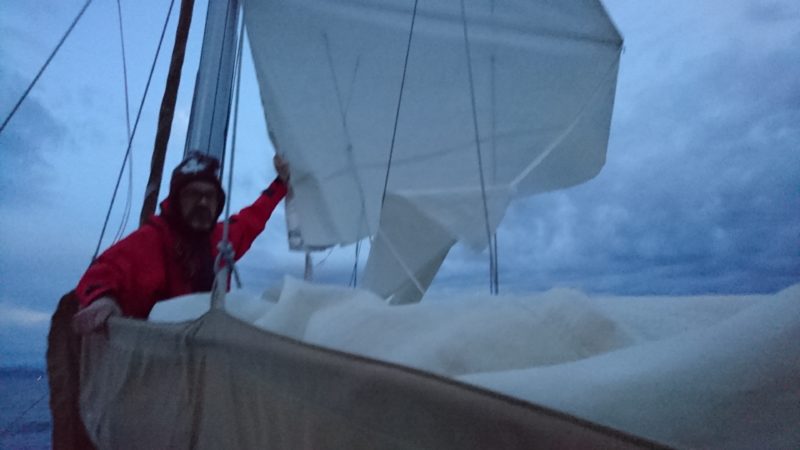 By daybreak, the storm had eased and the tattered silhouette of the sail waved at us through the twilight. A sad sight, but we were lucky not have suffered worse. The sail had been torn across half way up with a few shreds linking the halves together. Thomas had found his repair had held but the sail had torn away from the rest of the fitting. He tidied up the sail from the mast end while I tried to zip up the cover from the other end. I thought the zipper had been torn away but it was discovered later hidden by a velcro cover. Meanwhile, we bound the sail up with a line to make ourselves decent before we entered Porto di Palermo.
By daybreak, the storm had eased and the tattered silhouette of the sail waved at us through the twilight. A sad sight, but we were lucky not have suffered worse. The sail had been torn across half way up with a few shreds linking the halves together. Thomas had found his repair had held but the sail had torn away from the rest of the fitting. He tidied up the sail from the mast end while I tried to zip up the cover from the other end. I thought the zipper had been torn away but it was discovered later hidden by a velcro cover. Meanwhile, we bound the sail up with a line to make ourselves decent before we entered Porto di Palermo.
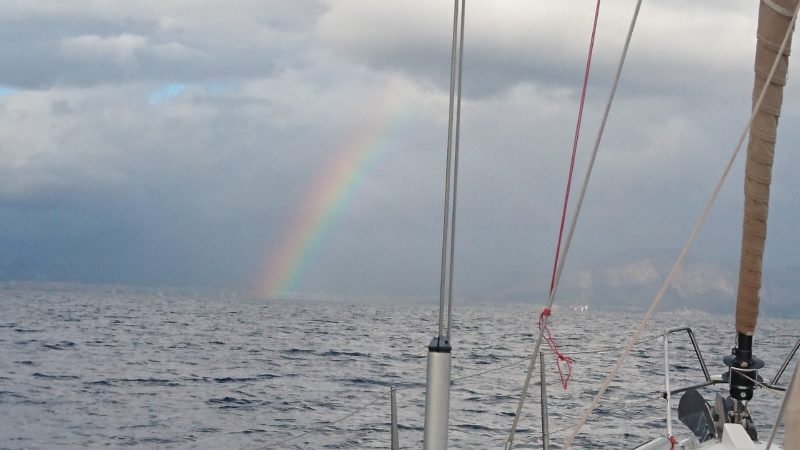 We approached Palermo with sunlight penetrating the clouds and a rainbow arcing over the bay. A stark contrast to what went only hours before: perhaps a salute from the old god of thunder… Thomas is fluent in Italian so was easily able to use the VHF to locate a marina close to a sailmaker. Maybe the sail could be stitched back together. We would soon see.
We approached Palermo with sunlight penetrating the clouds and a rainbow arcing over the bay. A stark contrast to what went only hours before: perhaps a salute from the old god of thunder… Thomas is fluent in Italian so was easily able to use the VHF to locate a marina close to a sailmaker. Maybe the sail could be stitched back together. We would soon see.
 Porto di Palermo is not pretty by any stretch, but the rusting cranes on the concrete shore were every bit as welcoming as Caribbean palms on a sun-kissed beach. The approach to the port was flat calm and the soggy grey clouds dissolved into the cool blue sky with hardly a breeze beneath the warm early morning sun and we coasted through the industrial iron seascape of Porto di Palermo toward Marina Nautico Galizzi.
Porto di Palermo is not pretty by any stretch, but the rusting cranes on the concrete shore were every bit as welcoming as Caribbean palms on a sun-kissed beach. The approach to the port was flat calm and the soggy grey clouds dissolved into the cool blue sky with hardly a breeze beneath the warm early morning sun and we coasted through the industrial iron seascape of Porto di Palermo toward Marina Nautico Galizzi.
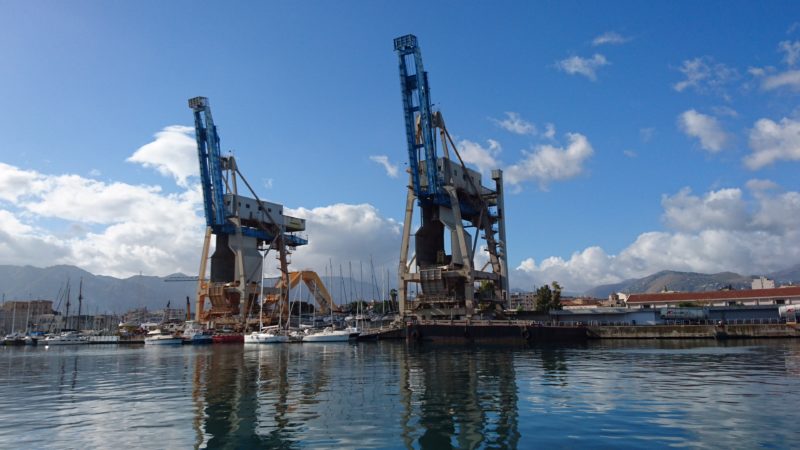 Bad weather was forecast. Palermo was one of our intermediate destinations for sheltering from the forthcoming front, the other being the more beautiful Trapani. We had made it on schedule but not in the manner we had planned… and we had three days to make repairs if we weren’t to lose any time, and Palermo might just be the place to do that…
Bad weather was forecast. Palermo was one of our intermediate destinations for sheltering from the forthcoming front, the other being the more beautiful Trapani. We had made it on schedule but not in the manner we had planned… and we had three days to make repairs if we weren’t to lose any time, and Palermo might just be the place to do that…
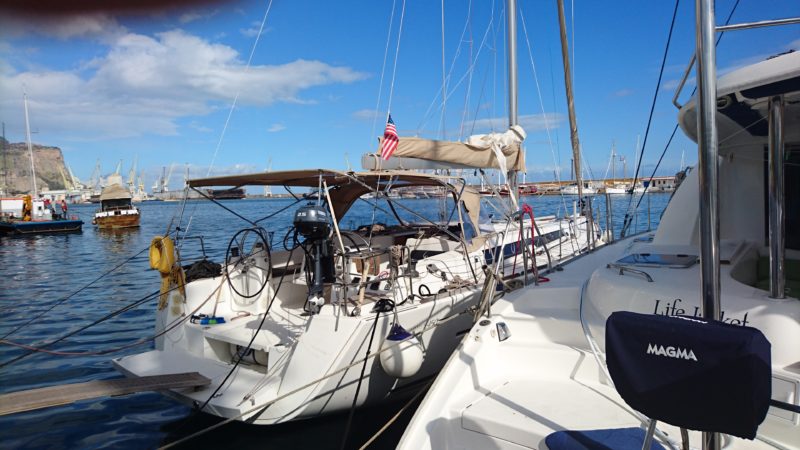



That is amazing. You have learned lots of ‘sailor speak’ in such a short time. You should collate all these blogs into a book for intrepid sailors thinking about an adventure afloat.